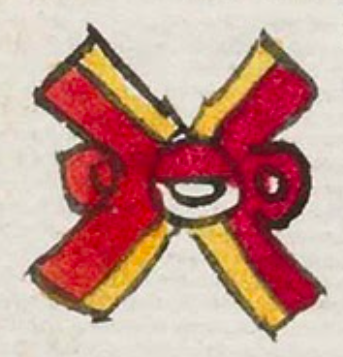olin (Mdz40r)
This simplex glyph, for the place name Olinallan, is a representation of movement (including the movement of earthquakes), called olin. It has two bent, double lines, coming together in the middle to form a shape like an X. The inner part of the X is painted yellow, and the outer part is red. At the intersection of the X is an eye, outlined in black and otherwise white, but with a red eyelid. Outside the X shape are two small circles, each with smaller concentric circles. These smaller circles are both red on their outer rings. One is white in the middle and the other is red in the middle.
Stephanie Wood
The shape of this glyph has the effect of a quatrefoil or quincunx (recognizing the center), slightly reminiscent of tonatiuh and xihuitl. Olin is the seventeenth of the twenty signs days of the tonalpohualli calendar, so they all share a temporal meaning. This quincunx also has a "starry eye" (star) in the middle, reminiscent of representations of nighttime, yohualli, and connecting movement to the cosmos and the movement of planets. The x-like cross in this quincunx is red (outside) and yellow-gold (inside). See another representation of olin from the Codex Borbonicus, with the added value of the number four, referring to the date Nahui Olin. This glyph from the Codex Mendoza is quite different from the olin glyph in the Codex Magliabecchiano, which has an added point at the top (in yellow, green, and red) and a shape at the bottom (in green, red, and white) something like the quincunx on the tonatiuh glyph. The x-shape of the Magliabecchiano olin is green on the left and yellow on the right, with an internal red line. Its concentric circles on right and left have red centers. The eye at the center is outlined half green and half yellow, with a red lid, white pupil, and white eyeball.
Stephanie Wood
Stephanie Wood
c. 1541, or by 1553 at the latest
Stephanie Wood
Joseph Scott and Crystal Boulton-Scott made the SVG.
movement, movimiento, days, días, fechas, dates, calendarios, calendars

olin, movement, earthquake, https://nahuatl.wired-humanities.org/content/olin
https://nahuatl.wired-humanities.org/content/coltotlel movimiento, un signo calendárico
Stephanie Wood
Codex Mendoza folio 40 recto, https://digital.bodleian.ox.ac.uk/objects/2fea788e-2aa2-4f08-b6d9-648c00..., image 90 of 188.
The Bodleian Libraries, University of Oxford, hold the original manuscript, the MS. Arch. Selden. A. 1. This image is published here under the UK Creative Commons, “Attribution-NonCommercial-ShareAlike 3.0 License” (CC-BY-NC-SA 3.0).




